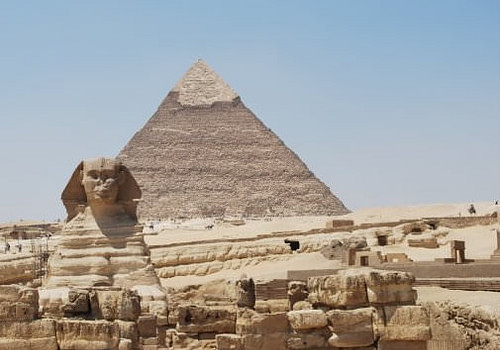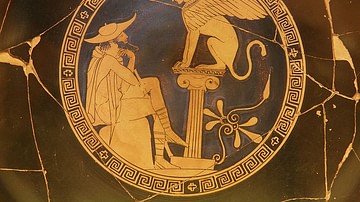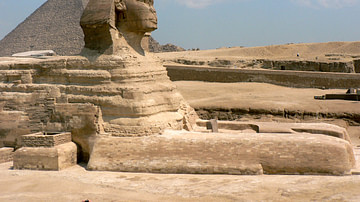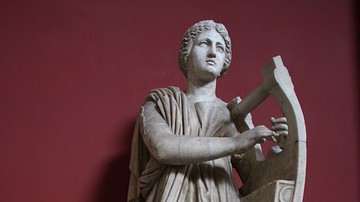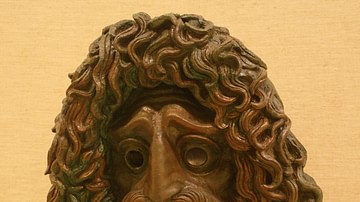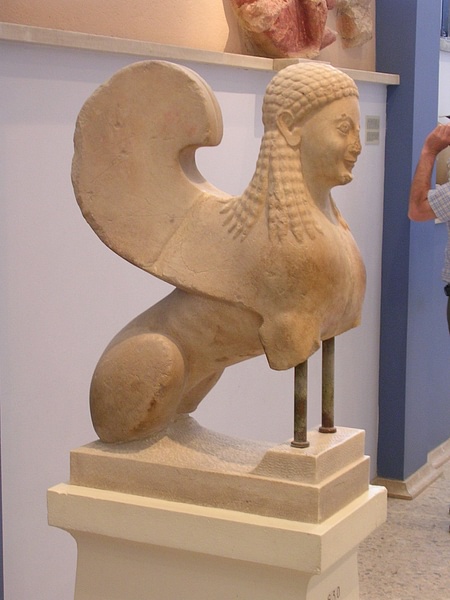
A Sphinx is a mythical creature with the body of a lion, most often with a human head and sometimes with wings. The creature was an Egyptian invention and had a male head - human or animal; however, in Greek mythology, the creature had the head of a woman. The sphinx is also present in the art and sculpture of the Mycenaean, Assyrian, Persian and Phoenician civilizations.
Egyptian Sphinxes
Sphinxes were first created by the Egyptians and usually wore a nemes (head-dress) as worn by Pharaohs. Examples exist of sphinxes with human faces but surrounded by a lion's mane, particularly from Nubia, and in the New Kingdom the head was sometimes that of a ram and representative of Amun. The exact date when the first sphinx appeared is not known and the most famous sphinx of all, the Great Sphinx of Giza, has not been precisely dated; some scholars date it as far back as the reign of Cheops, ca 2500 BCE. There is a story that in the Eighteenth Dynasty, Pharaoh Thutmose IV, when he was a mere prince, went on a hunting expedition and fell asleep in the shadow of the Sphinx. Whilst asleep he dreamt that the Sphinx spoke to him and promised that he would become king if he cleared the sands that had accumulated around the feet of the statue. In the reign of Chephren, sphinxes became more widespread and they were usually placed as guards outside or beside a mortuary temple, tomb or funerary monument.
Minoan & Mycenaean Sphinxes
Sphinxes were also present in the art of the Minoan and Mycenaean cultures from the early second millennium BC. The earliest examples are found on clay relief plaques used to decorate pottery vessels and on beaten gold dress ornaments from Minoan Crete. Later, three-dimensional sphinxes were similarly added to clay vessels and a surviving fresco from Pylos also depicted the mythical creature. In the 13th century BCE there are examples of pottery found in Cyprus (but probably manufactured on the Greek mainland) with painted sphinxes in silhouette, often in pairs and positioned heraldically. Sphinxes were also a popular subject for Mycenaean ivory carvings, usually in the form of plaques and small, lidded boxes.
Assyrian & Persian Sphinxes
The sphinx was also commonly represented in both Assyrian and Persian art, usually with wings and a male human head. Large, sculpted sphinxes in the shape of winged bulls often stood in pairs outside palaces and guarded against evil forces. Such an example is the large sphinx presently in the British Museum which once stood outside the palace of Ashurnasirpal II at Nimrud (ca 865 BCE). Persian architecture often incorporated sphinxes in low-relief in walls and gates, examples from Susa (6th century BCE) and Persepolis (4th century BCE) depict male-headed sphinxes wearing divine horned headdresses.
The Sphinx in Classical Greece
In contrast to the Egyptian view, the sphinx of Greek mythology was a more troublesome creature and the most famous myth involving a sphinx is that of the Theban prince Oedipus: The territory of Thebes in Greece was terrorized by a sphinx and Hesiod tells us in his Theogony that the creature was born from the Chimaera (a fire-breathing monster with three heads and a body part lion, goat, snake and dragon) and was sister to the Nemean lion and half-sister of Kerberos (the three-headed dog that guarded Hades). The sphinx created drought and famine and would only leave the Thebans alone if they solved her riddle. This was to define the creature that has two, three or four feet and although it is able to change its form, it moves slower the more feet it uses. Anyone who dared to answer the riddle and failed to do so correctly was killed and devoured by the sphinx. When the sphinx killed his son Haimon, Kreon, the king of Thebes became so desperate at the situation that he offered his kingdom and his daughter Iokaste to anyone who could answer the riddle. Oedipus took up the challenge and gave the correct answer —man— and in frustration and anger the sphinx leapt to her death from the acropolis of Thebes. Scenes of the hero with the mythological creature are the most common depictions in art of the Oedipus myth and appeared from the 6th century BC on pottery, on carved gems and as a decorative device on fabrics.
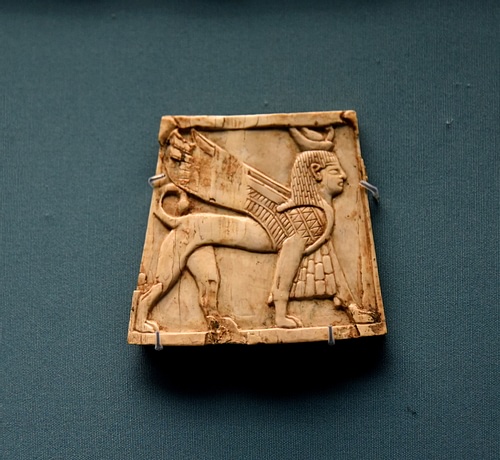
In ancient Greek culture, the first sphinxes to appear in sculpture appeared from the 7th century BCE. These were made from clay and are particularly associated with Crete where moulded heads of sphinxes were sometimes added to pithoi. From the 6th century BCE, the Greek sphinx appeared in stone sculpture, sometimes with raised hind quarters. These sculptures were used as votive offerings, usually perched atop tall Ionic or Doric columns and placed at sanctuary sites such as Delphi and Olympia. Indeed, one of the most famous sphinxes was discovered at Delphi; originally sat on a 10m high Ionic column, it had been dedicated to the oracle by the Naxians around 560 BCE. In gratitude for the dedication, the priests of Apollo gave citizens of Naxos the privilege of priority (promanteia) when consulting the oracle.
Sphinxes also commonly appeared atop funerary stelai and were usually brightly painted. A surviving example from Attica (around 540 BCE) displays traces of paint and would have originally had black hair, wing feathers in green, blue, black and red and breast scales in red and blue. Interestingly, when used in votive offerings the head always faced forwards whilst sphinxes on funerary stelai always faced sideways. A third use of the mythical creature, possibly borrowed from Syria or Cyprus, was as a decorative support base for carved stone water basins (perirrhanteria), which were used in sanctuaries.
Other famous depictions in art of sphinxes include the three which topped the crested helmet of the Athena Parthenos statue by Pheidias which stood in the Parthenon and the sphinxes which adorned the feet of the throne of Zeus at Olympia.
